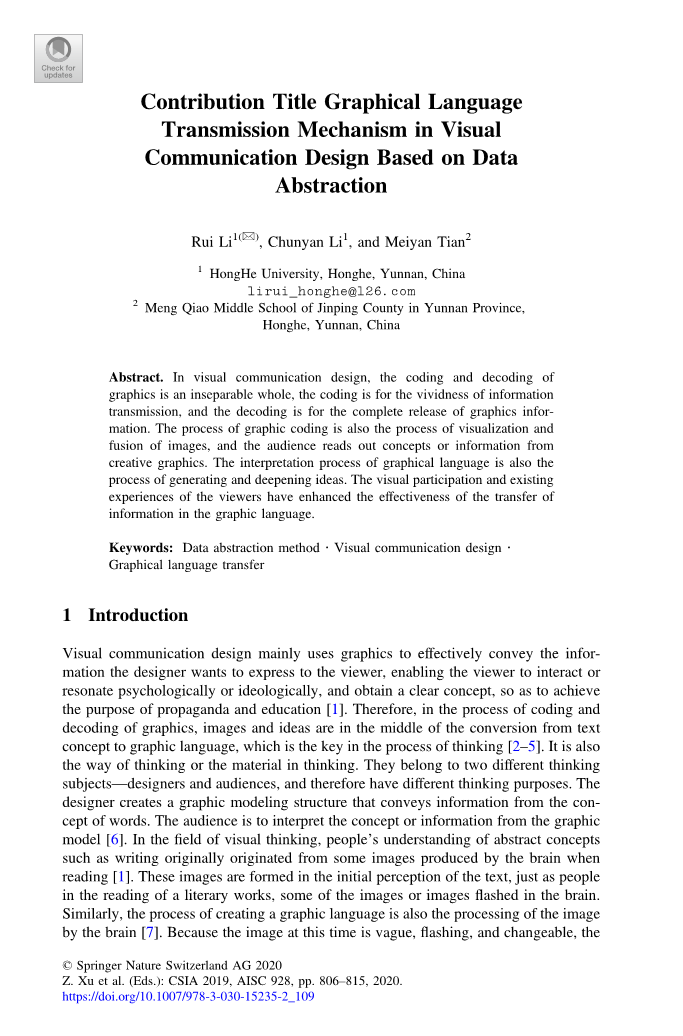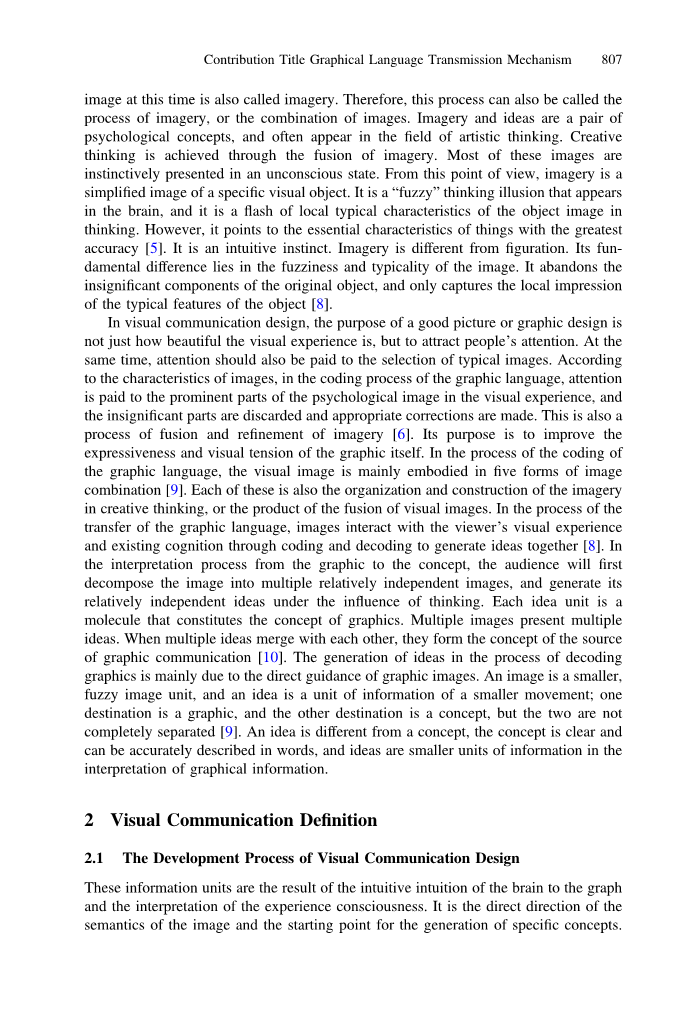

英语原文共 10 页,剩余内容已隐藏,支付完成后下载完整资料
Visual communication design mainly uses graphics to effectively convey the information the designer wants to express to the viewer, enabling the viewer to interact or resonate psychologically or ideologically, and obtain a clear concept, so as to achieve the purpose of propaganda and education [1]. Therefore, in the process of coding and decoding of graphics, images and ideas are in the middle of the conversion from text concept to graphic language, which is the key in the process of thinking [2–5]. It is also the way of thinking or the material in thinking. They belong to two different thinking subjects—designers and audiences, and therefore have different thinking purposes. The designer creates a graphic modeling structure that conveys information from the concept of words. The audience is to interpret the concept or information from the graphic model [6]. In the fifield of visual thinking, peoplersquo;s understanding of abstract concepts such as writing originally originated from some images produced by the brain when reading [1]. These images are formed in the initial perception of the text, just as people in the reading of a literary works, some of the images or images flflashed in the brain. Similarly, the process of creating a graphic language is also the processing of the image by the brain [7]. Because the image at this time is vague, flflashing, and changeable,the image at this time is also called imagery. Therefore, this process can also be called the process of imagery, or the combination of images. Imagery and ideas are a pair of psychological concepts, and often appear in the fifield of artistic thinking. Creative thinking is achieved through the fusion of imagery. Most of these images are instinctively presented in an unconscious state. From this point of view, imagery is a simplifified image of a specifific visual object. It is a “fuzzy” thinking illusion that appears in the brain, and it is a flflash of local typical characteristics of the object image in thinking. However, it points to the essential characteristics of things with the greatest accuracy [5]. It is an intuitive instinct. Imagery is different from fifiguration. Its fun damental difference lies in the fuzziness and typicality of the image. It abandons the
insignifificant components of the original object, and only captures the local impression of the typical features of the object [8].
In visual communication design, the purpose of a good picture or graphic design is not just how beautiful the visual experience is, but to attract peoplersquo;s attention. At the same time, attention should also be paid to the selection of typical images. According to the characteristics of images, in the coding process of the graphic language, attention is paid to the prominent parts of the psychological image in the visual experience, and the insignifificant parts are discarded and appropriate corrections are made. This is also a process of fusion and refifinement of imagery [6]. Its purpose is to improve the expressiveness and visual tension of the graphic itself.In the process of the coding of the graphic language, the visual image is mainly embodied in fifive forms of image
combination [9]. Each of these is also the organization and construction of the imagery in creative thinking, or the product of the fusion of visual images. In the process of the
transfer of the graphic language, images interact with the viewerrsquo;s visual experience and existing cognition through coding and decoding to generate ideas together [8]. In the interpretation process from the graphic to the concept, the audience will fifirst decompose the image into multiple relatively independent images, and generate its relatively independent ideas under the inflfluence of thinking. Each idea unit is a molecule that constitutes the concept of graphics. Multiple images present multiple ideas. When multiple ideas merge with each other, they form the concept of the source
of graphic communication [10]. The generation of ideas in the process of decoding graphics is mainly due to the direct guidance of graphic images. An image is a smaller, fuzzy image unit, and an idea is a unit of information of a smaller movement; one destination is a graphic, and the other destination is a concept, but the two are not completely separated [9]. An idea is different from a concept, the concept is clear and can be accurately described in words, and ideas are smaller units of information in the interpretation of graphical information.
视觉传达设计主要利用图形来向观众传达设计者想要表达的信息,使观众能够在心理或思想上进行互动或共鸣,获得清晰的概念从而达到宣传教育的目的。因此,在图形的编码和解码过程中,图像和思想处于从文本概念到图形语言的转换过程中,这是思维过程中的关键环节。它也是思维的方式,也是思维的物质。他们属于两个不同的思维主体—设计师和观众,因此有不同的思维目的。设计人员创建了一个图形造型结构,它从单词的概念中传递信息。观众是从图形模型中解释概念或信息。在视觉思维领域,人们对写作等抽象概念的理解起源于阅读时大脑产生的一些意象。这些图像是在最初对文本的感知中形成的,就像人们在阅读文学作品时一样,一些图形或图像在大脑中闪现。同样,创造图形语言的过程也是大脑对图像的处理。因为此时的图像模糊、闪烁、多变,此时的图像也被成为意象。因此,这一过程也可以成为意象的过程,或图像的组合。意象和思想是一对心理概念,经常出现在艺术思维领域。创造性思维是通过意象的融合来实现的。大多数这些图像都是本能地呈现在无意识的状态中。从这个角度来看,图像是特定视觉对象的简化图像。它是一种出现在大脑中的“模糊”思维错觉,是思维中对象形象局部典型特征的闪现。然而,它以最大的准确性指出了事物的本质特征。这是直觉,意象不同于形象化。其根本区别在于形象的模糊性和典型性。它放弃了原始对象中微不足道的组件,只捕捉到对象的典型特征的本地印象。
在视觉传达设计中,好的图片或平面设计的目的不仅仅是视觉体验的美,而是吸引人们的注意力。同时,也要注意典型图像的选择。根据图像的特点,在图形语言的编码过程中,注意视觉体验中心理意象的突出部分,丢弃不重要的部分,进行适当的纠正。这也是图像融合和细化的过程,其目的是提高图形本身的表现力和视觉张力。在图形语言的编码过程中,视觉图像主要表现为图像组合的五种形式。每一个都是创造性思维中意象的组织和构建,或者是视觉图像融合的产物。在图形语言的转换过程中,图像通过编码和解码与观众的视觉体验和现有认知相互作用,共同产生思想。在从图形分解为多个相对独立的图像,并在思维的影响下生成其相对独立的思想。每个概念单位都是构成图形概念的分子。多幅图像呈现出多种想法。当多种思想相互融合时,它们形成了图形通信的来源概念。图形解码过程中思想的产生主要是由于图形图像的直接引导。图像是一个较小的、模糊的图像单元,一个想法是一个较小运动的信息单位;一个目的地是图形,另一个目的地是一个概念,但两者不是完全分开的。一个概念与一个概念是不同的,概念的清晰的,可以用文字准确地描述的,思想是较小的信息单位在图形信息的解释中。
剩余内容已隐藏,支付完成后下载完整资料
资料编号:[239220],资料为PDF文档或Word文档,PDF文档可免费转换为Word


